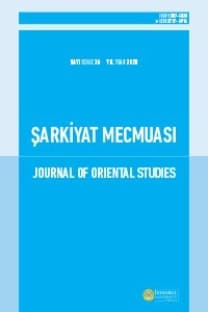A Review of Khitan Language Materials
A Review of Khitan Language Materials
The Khitan people, who have now disappeared for a long time, were an important group during the medieval period in East and Central Asia. Despite having established the Liao Dynasty and the Qara Khitai states, their language and script were forgotten following the Mongol conquests and they were largely assimilated by the Mongols. As a matter of fact, Yelü Chucai was perhaps the most famous Khitan of his time, and in modern times, studies on Yelü Chucai surpass those on Abaoji, the founder of the Liao dynasty. He has been presented as a great intellectual by his Chinese, Mongol and Khitan contemporaries as well as modern historians. However, this article aims to demonstrate that there was nothing extraordinary about a Khitan being on par with his Han Chinese, Persian or Central Asian counterparts intellectually by the time of Chucai, and his success was a culmination of over a century of Khitan tradition in both Khitan and Chinese. This study introduces and examines the development of the written tradition in the Khitan language and aims to demonstrate that Yelü Chucai was not an exception, but rather the norm by the time of Jinggis Qaghan, who called him “urtuq saqal”. The approach to Khitan literature was divided along historical period lines rather than linguistic lines. The Khitan words and titles have been written in Latin letters, since it was not possible to write them in either Khitan scripts.
___
- Atik, Kubilay. “A Comparison of Komnenos Era Byzantine and Song Era Chinese Diplomacy with Nomadic Neighbors.” Atatürk Üniversitesi Türkiyat Araştırmaları Enstitüsü Dergisi 70, no. 1 (2021): 343–58. http:// www.turkiyatjournal.com/DergiTamDetay.aspx?ID=4433.
- Atik, Kubilay. “Ortaçağ Bozkır Devletlerinde Hayvancılık Üzerine Yasalar: Tangut Devleti Örneği.” Erzincan Üniversitesi Sosyal Bilimler Enstitüsü Dergisi 13, no. 2 (2020): 183–98. doi:https://doi.org/10.46790/ erzisosbil.798191.
- Barfield, Thomas. The Perilous Frontier: Nomadic Empires and China, 221 BC to AD 1757. New York: Wiley, 1992.
- Ivliev, Alexander Lvovich. “Соотношение Культур Империи Ляо и Киданей [Sootnosheniye Kul’tur Imperii Lyao i Kidaney].” Археология и Этнография Народов Дальнего Востока. Сборник Научных Трудов. Владивосток [Arkheologiya i Etnografiya Narodov Dal’nego Vostoka. Sbornik Nauchnykh Trudov. Vladivostok], 1984.
- Kane, Daniel. The Kitan Language and Script. Vol. 166. Leiden: Brill, 2009. Kradin, Nikolai N., and Stanislav Prokopets. Великая Киданьская Стена: Северо-Восточный Вал Чингис- Хана. Moscow: Nauka, 2019.
- Rudov, L. N. “Проблемы Киданьской Письменности.” Сов. Этнография, no. 1 (1963).
- Shavkunov, Vladimir Ernstovich. “К Вопросу о Расшифровке Малой Кидань-Чжурчжэньском Письменности [K Voprosu o Rasshifrovke Maloy Kidan’-Chzhurchzhen’skom Pis’mennosti: On the Issue of Deciphering Khitan Small-Jurchen Writing].” Eppgrafnka Vostoka 15 (1963).
- Shimunek, Andrew E. Towards a Reconstruction of the Kitan Language, with Notes on Northern Late Middle Chinese Phonology. Bloomington: Indiana University, Department of Linguisitcs and the Department of Central Eurasian Studies, 2007.
- Skaff, Jonathan Karam. “Barbarians at the Gates? The Tang Frontier Military and the An Lushan Rebellion.” War & Society 18, no. 2 (2000): 23–35. http://www.maneyonline.com/doi/abs/10.1179/072924700791201658.
- Standen, Naomi. Unbounded Loyalty: Frontier Crossings in Liao China. Honolulu: University of Hawaii Press, 2007.
- Tan, John. “О ДВУХ ЗНАКАХ КИДАНЬСКОГО ПИСЬМА, ОТНОСЯЩИХСЯ К ЖЕЛЕЗУ.” ACTA LINGUISTICA PETROPOLITANA. ТРУДЫ ИНСТИТУТА ЛИНГВИСТИЧЕСКИХ ИССЛЕДОВАНИЙ 11, no. 3 (2015): 465–70. http://elibrary.ru/item.asp?id=25462828.
- Tao, Zongyi. “輟耕錄 [Chuo Genglu].” Accessed January 10, 2021. https://zh.wikisource.org/zh-hans/%E8 %BC%9F%E8%80%95%E9%8C%84. Taskin, Vsevolod Sergeyevich. “Опыт Дешифровки Киданьской Письменности [Opyt Deshifrovki Kidan’skoy Pis’mennosti: Experience Deciphering Khitan Script].” Narody Azii i Afrikii, no. 1 (1963).
- Vovin, Alexander. “Did the Xiongnu Speak a Yeniseian Language.” Central Asiatic Journal 44, no. 1 (2000): 87–104.
- Wu, Yingzhe, and Juha Janhunen. New Materials on the Khitan Small Script A Critical Edition of Xiao Dilu and Yelü Xiangwen. Corpus Scriptorum Chitanorum 1. Kent: Global Oriental, 2010.
- Yunusoğlu, Mağrifet Kemal. Uygurca-Çince İdikut Sözlüğü. Istanbul: Türk Dil Kurumu Yayınları, 2012.
- Zaitsev, Vasiliy Petrovich. “Рукописная Книга Большого Киданьского Письма Из Коллекции Института Восточных Рукописей РАН [Rukopisnaya Kniga Bol’shogo Kidan’skogo Pis’ma Iz Kollektsii Instituta Vostochnykh Rukopisey RAN].” Письменные Памятники Востока [Pis’mennyye Pamyatniki Vostoka: Written Monuments of the Orient], no. 2 (2011): 15.
- Zaitsev, Vyacheslav Petrovich. “Идентификация Киданьского Исторического Сочинения В Составе Рукописной Книги-Кодекса Nova Н 176 Из Коллекции Ивр Ран И Сопутствующие Проблемы [Identifikatsiya Kidan’skogo Istoricheskogo Sochineniya V Sostave Rukopisnoy Knigi-Kodeksa Nova N 176 Iz Kollektsii Ivr Ran I Soputstvuyushchiye Problemy].” Acta Linguistica Petropolitana-Trudy Instituta Lingvisticheskikh Issledovaniy 11, no. 3 (2015): 167–208. http://www.academia.edu/download/40789881/ zaytsev_2015.pdf.
- ISSN: 1307-5020
- Yayın Aralığı: 2
- Başlangıç: 1956
- Yayıncı: İstanbul Üniversitesi Edebiyat Fakültesi Şarkiyat Araştırma Merkezi
